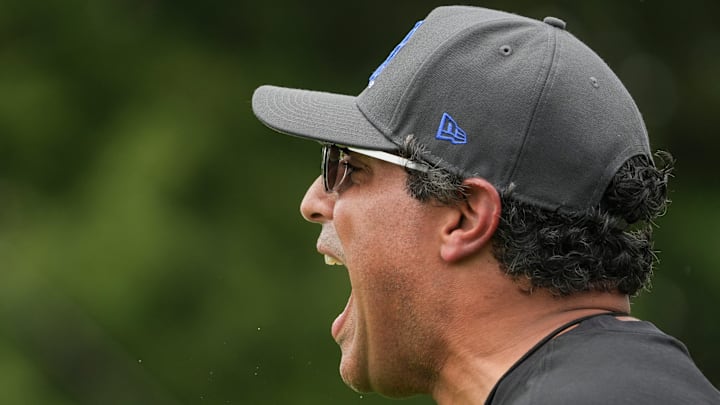By almost every measure, Kentucky football's 2024 offense was a mess. Sluggish tempo, baffling play calling, no rhythm, and no identity — it was the kind of offense fans hadn’t seen since Mark Stoops’ early years trying to build something from the ground up. But unlike those rebuilding seasons, this time there were expectations. A veteran roster. A new offensive coordinator in Bush Hamdan who talked a big game.

“We're going to run 100 plays a game and be the fastest offense in the country!” Hamdan said in the preseason.
That never came remotely close to happening.
Instead, Kentucky averaged just 64.3 plays per game — 112th in the country. They ranked 124th in points per game, 124th in total yards, 116th in yards per play. The Wildcats weren’t just underperforming; they were barely functioning. The passing game was among the worst in all of FBS, the rushing attack was mediocre, and third down efficiency — a key barometer of good play calling — was near the bottom nationally.
The playbook looked stuck in neutral, and so did the team.
And yet, Mark Stoops stayed the course. After cycling through a carousel of offensive coordinators since 2020, he’s doubling down on Hamdan for 2025 — a gamble that may shape the narrative of his entire second decade in Lexington.
A long line of one-and-dones
Since Eddie Gran’s five-year run ended in 2020, Kentucky has had a different OC every season:

- Liam Coen (2021, 2023)
- Rich Scangarello (2022)
- Bush Hamdan (2024)
That kind of turnover kills consistency. But Hamdan’s nomadic career raises its own questions. Since entering the coaching world in 2009, he's worked at 10 different colleges and spent a year in the NFL. Kentucky is his 11th stop — and his fifth offensive coordinator job. The bigger concern? At several of those schools, the offense improved after he left.
The “better without him” pattern
At Boise State in 2023, Hamdan’s offense averaged about 436 yards per game and leaned heavily on the run. Not terrible. But the following season, after his departure, Boise jumped to 466 yards per game, with more scoring, better efficiency, and fewer turnovers. It wasn’t a small uptick — it was a clear upgrade.

Go back to his stint at Washington and you’ll find a similar trend. In 2017, Jake Browning posted a 152.1 passer rating. Under Hamdan in 2018, that dropped to 142.5 — more interceptions, fewer touchdowns, and less explosiveness. In 2019, the year after Hamdan was let go, Washington’s offense didn’t take off dramatically, but it stabilized and became more efficient.
In short: wherever Hamdan goes, stagnation seems to follow. And when he leaves, things tend to improve.
2024 at Kentucky: The stats speak loudly
Kentucky’s offense in 2024 was statistically dreadful:
- 18.1 points per game (124th nationally)
- 307.5 yards per game (124th)
- 33.6% on third down (119th)
- 51.97% completion rate (128th)
- 5.38% interception rate (worst in the country)
The Wildcats couldn’t throw, couldn’t sustain drives, and couldn’t adapt. Even red zone scoring — usually a mark of good preparation — ranked 118th. Outside of kicking (92.9% field goal rate), there were no bright spots.

Worse yet, the pace of play felt almost deliberate in its slowness. Stoops has never been one to chase tempo, but in today’s SEC, if you’re the less talented team — and Kentucky often is — you need to create structural advantages. Tempo is one of them. It forces defenses to stay vanilla. It creates mismatches. It wears down talent gaps.
Instead, Kentucky allowed opponents to substitute freely, stay fresh, and pin their ears back on key downs.
Can it get better in 2025?
Sure. Continuity can help. Hamdan now knows the roster better. The offensive line should improve, and the quarterback room should be more settled. But here's the thing: optimism without results is just hope, and Kentucky fans are tired of hoping the offense will eventually click.
Hamdan’s track record doesn’t scream second-year breakout. If anything, it raises red flags. His teams don’t evolve midstream. They tend to limp along, and then get better after he's gone.
If there’s a true shift coming in 2025, it needs to show up early and often — starting with a sense of urgency and modernity. Kentucky doesn’t have to become Oregon overnight, but it can’t keep pretending slow, plodding football will somehow start winning shootouts.
Motivated Mark Stoops problem
Ultimately, this isn’t just about Hamdan. It’s about Stoops. He’s built one of the most consistent programs in the SEC outside of the traditional powers until 3 years ago when it began crumbling. But his refusal to adapt offensively may be what caps Kentucky’s ceiling. That worked when defenses dominated. Now, it’s the era of 35-point Saturdays. Playing keep-away doesn’t work when you can’t move the chains or score in the red zone.
Unless Stoops lets go of some control and lets Hamdan — or anyone — implement a faster, more aggressive approach, Kentucky will remain stuck in neutral.
Final thought
Bush Hamdan promised Kentucky would “run 100 plays a game.” Instead, they ranked 112th in tempo and 124th in just about everything else. If Year 2 doesn’t deliver a leap forward, Mark Stoops won’t just have an OC problem — he’ll have a program identity crisis on his hands, again.
